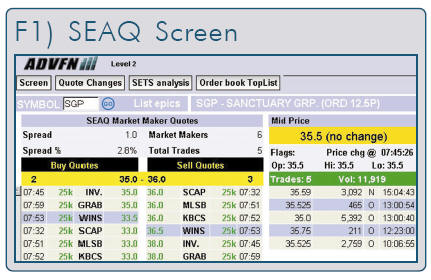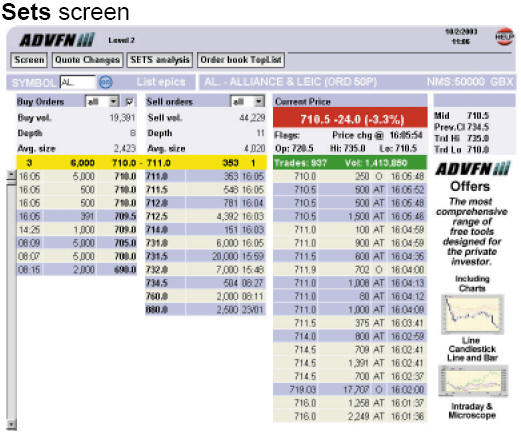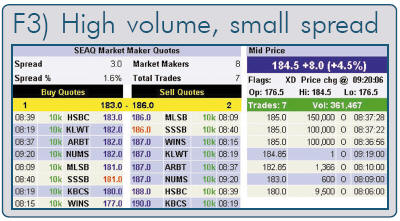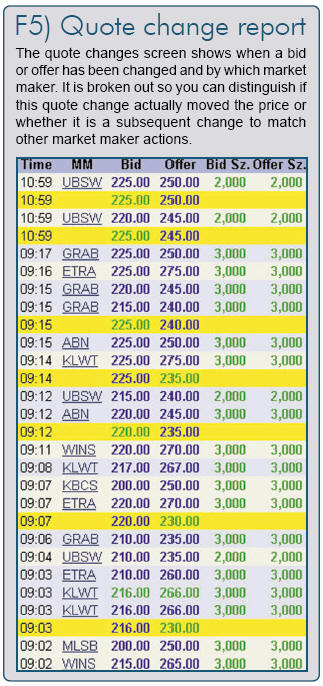This article uses ADVFN Level 2 to illustrate the text. The ADVFN Level 2 screen is more than just Level 2 data. When a trade is made, it is made through the market maker and the bargain becomes a transaction. This transaction flow gives a history of what market makers have been trading throughout the day on that stock. This information is held on the level 2 screen for convenience so that you can see the Market Maker positions and consider them in the light of the history of trades.
Also on the Level 2 SEAQ screen level 1 information such as Previous close, the highest trade price, the lowest trade price, the mid trade price price, the Normal Market Size, number of trades, total volume so far traded today are held on the screen for convenience.
The more of a picture of the state of the market you have and the recent history that produced the current price, the more able you will be to predict an outcome.
To the left of the screen the actual Level 2 information is held. On the left side are the Bid prices, the prices that market makers will buy stock from you. On the right are the prices market makers will sell to you. The Strip above these quotes contain the highest bid and the lowest offer being put forwarded by the combined market makers and is the Bid Offer spread you see on level one. The price quoted is normally the MID, the MID just being half way between the BID OFFER.
On the strip on either side of the BID OFFER price is a number representing the number of Market Markers actually at the BID or OFFER. So for example only 1 out of 4 market makers will buy at the BID price while maybe all 4 will sell at the OFFER price. The balance of market makers is of course information that may lead you to expect a price change.
|
| |
 |
|
 |
 |
To use the Level 2 SEAQ book to your advantage you must first understand how a market maker works.
Even though a market maker is now highly computerised he is still basically trying to sell at the offer and buy at the bid. In his ideal world buyers would match sellers and there would be lots of trades. The price would not move and the Market Maker would simply make his margin day in and day out.
A market maker does not want to hold stock, nor does he want to be short. The basis of his business is to earn the spread in return for facilitating the market. However life is not often that simple.
In the real world the balance between buyers and seller swing in and out of balance, so a market maker has shares put on him for a period which he holds and then has them brought off him in droves at another moment. Seeing that he does not wish to hold a large inventory of stock, which would make him an investor rather than a market maker, large swings in demand and supply have a dramatic effect of his net position in a stock.
For example a market maker has a small amount of stock in company AAA, say 100,000 and suddenly it is tipped in a Sunday paper. The result is he has 200,000 shares bought off him. The market maker is now 100,000 shares short. He will then move the bid up and his offer up. This will make him more expensive to buy from than the other market makers and stop anyone buying off him and increase the price he is willing to pay for the stock. This hopefully will enable him to find a seller to fill his short position, again hopefully at a price that does not cancel out his profit on the spread. This sale might come from a normal investor or he might approach another market maker who may sell the stock to him. As the bid and offer has risen so the mid price has risen too. The share has gone up.
If he was not the only Market Maker on the Offer, the offer price may not go up, only the Bid. The remaining market makers may have stock to sell. However now there are less market makers offering at that price and if buyers continue then they too will have to raise their offer and if they are to buy new stock, raise there bid price too. In the SEAQ book you can see Market Makers move their bid and offer prices as orders are executed.
If there are sellers exactly the opposite happens. To stop having to buy stock at the quoted price a market maker will drop his bid price and drop his offer to try and sell stock he has just bought. Other market makers will follow suit because they have now become the focus of seller attention or because they do not wish to become the market maker buying at this price. This process can be seen unfolding on Level 2 and give a strong indication of market direction.
This is the basic level of how a market makers system works, but like all basic systems it often bears little resemblance to what really happens. The model above is a rather passive one in which the market maker responds to supply and demand. So for example company AAA announces that its factory has burnt down, then the market maker would simply wait for seller to appear and mark down the price to the ebb and flow of buys and sells. This of course could never happen.
Instead, the market maker hearing the news, will arbitrarily mark the price down to a level where he thinks the market for buyers and seller will be matched. In this example he has no wish to buy shares at every penny drop from 100p to 30p till buyers want to take them. Clearly he would take a big loss if he did.
The market maker therefore simply drops the price to 30p and sees what happens next. If buyers flooded in he would mark the price to 40p, then 50p until buyers and sellers agreed through the balance of orders that the price was right subsequent to the news. During this process the spread would OPEN, or put another way, the percentage between the BID and the OFFER would increase. This is because the Market Markers need more profit to compensate for the risk of an uncertain market. In a volatile market the desire of the market makers not to be on the Bid or Offer automatically opens the spread as they fall over each other not to be the firm called to make the market. When the spread is wide enough for greed to get the better of them they deal. The converse of this is also true. In a stock with a high level of trade volume and perhaps a low volatility, the spread will be small. This is because the risk to the market maker is low and competition with other market makers attracted to the stock is high. Again the ebb and flow can be seen unfolding on the Level 2 SEAQ screen.
 |
So the movement and size of the spread is also an important indicator for the state of the market in a share and the likelihood of its future movements. The make up and evolution of this can be studied using Level 2.
There are two market makers in a stock. They are both on the bid and offer which is 9p bid, 10p offer.
Market Maker A receives an order 10p for 100,000 shares. He sells the shares. He only has 50,000 shares in his book and now has a position of -50000 shares. He marks his Bid/Offer to 9.5 10.5. The overall BID OFFER is now 9.5 10 so the mid price is 9.75, so the price has gone up 0.25.
The next order is a sell of 50,000 shares which Market Maker A buys and therefore closes his short position.
His profit on the 100,000 shares is 50,000 x 1p and 50,000 x 05.p is £750.
Meanwhile another order comes in for 100,000 shares and Market Maker B sells them to the customer. Market Maker B has 120,000 shares in his book and now only has 20,000.
The market is on the rise and he doesn't want to be short on a rising market so he moves his Bid Offer to match Market Maker A's Bid offer of 9.5p and 10.5p. The overall Bid has not moved but the Offer has, so the price goes up another 0.25p.
As you can see the spread went in as the price rose and went out again when it rose the second time and equilibrium with the other market maker was reached.
This simple example is the basics of how market makers interact with the market and themselves, but as you can see when a company has several market makers the interactions can become very complicated.
ADVFN has a unique tool to watch this process. It is called Quote changes and can be accessed from the Level 2 screen at the top highlighted in Blue.
 |
The 'Quote Changes' screen shows when a Bid or Offer has been changed and by which market maker. It is broken out so you can distinguish if this quote change actually moved the price or whether it is a subsequent change to match other market maker actions.
The first market maker listed after the yellow bar showing a change of the Bid and Offer is the market maker responsible for the change and those list after him are ones moving their prices accordingly. From this it can be judged which market maker is leading the market and/or who has received a trade that has made him amend his prices. Clicking on the Market Maker symbol will take you to a screen listing all that market makers moves of the day so that his other activities can be perused.
While it might seem apparent that buying will push up a price for a share, this is not always the case. It may seem perverse but buying can in some instances make the price drop. This is commonly know as the Market Maker 'shaking the tree.'
A sudden bout of buying may force a market maker or all the market makers to become short in a stock. They may find it difficult or impossible to find stock to cover this short. In this position raising the price will simply lose them money and what is more encourage more buyers to follow the appreciating share. It is after all a common belief that one should buy what is going up and that the 'trend is ones friend.' Whatever the case this is clearly not a kind position for a 'short' market maker to find himself in. In this instance the Market Maker will drop the price in the hope of creating sellers from which to cover his awkward position. Likewise if he is burdened with a long position he may attempt to create buy interest by marking the stock up. Because the SEAQ system is not automated, an understanding of market maker strategies is important to understand short term moves in stock prices. However we are reliably informed by academics, that in the long run the correct price for a stock will be reached.
I will end this section by a simple example of how a SEAQ Level 2 screen can help traders improve their profits. It is by no means a sole example but none the less a clear one.
A share you hold jumps 15% suddenly. This meets your sell price. You check Level 2. There are 5 Market Makers.
All market Makers are on the Bid at 11p. One Market Maker is on the Offer at 12p, 4 at 13p.
It seems highly likely that at least one Market Maker will raise the Bid to 11.25p another decent rise. There would also be plenty of time to sell into the Bid if the market started to weaken and Market Makers began 'coming off the bid.' The single market Maker on the Offer could easily dislodged to move higher putting upwards pressure on the price up.
You would be very tempted to wait for the Market Makers to come into line and the Level 2 screen would have helped you to a higher return.
Conversely if there was only 1 Market Maker left on the Bid, you would be quickly scrambling for the phone.
This strategy can also help you time entrance into a falling stock that has met its entry point. No point in buying in if the Market Makers are falling over themselves to drive the price lower. Waiting for some kind of price solidarity on the Offer may well be worth waiting for rather than grabbing at the mythical 'falling knife.'
Another benefit of a Level 2 screen I have found most useful is the ability to discuss price improvement with your broker. Brokers are often encouraged to try that little bit harder to get within the spread, when they know you are looking at the market with professional tools. This can equate to a very significant amount of money indeed, especially when dealing in 'Small Cap' shares with large spreads.
Level 2 - Sets Screen (1.74 Mb)
(1.74 Mb) (722 Kb)
(722 Kb)The content of this site is copyright 2016 Financial Spread Betting Ltd. Please contact us if you wish to reproduce any of it.